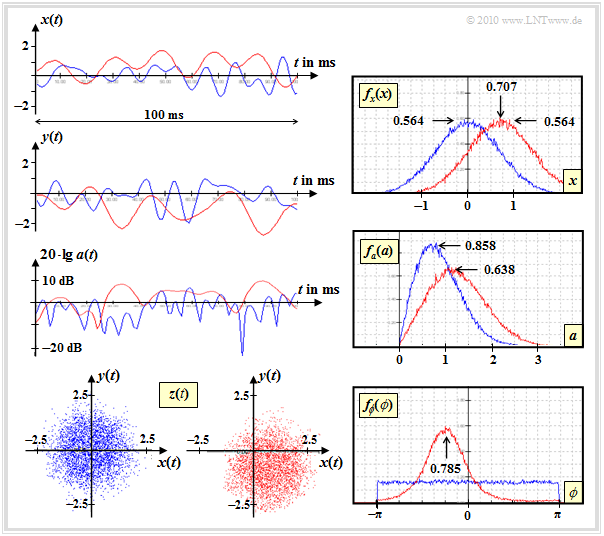Non-Frequency-Selective Fading With Direct Component
Contents
Channel model and Rice PDF
The Rayleigh distribution describes the mobile communication channel under the assumption that there is no direct path and thus the multiplicative factor $z(t) = x(t) + {\rm j} \cdot y(t)$ is solely composed of diffusely scattered components.
If a direct component ( Line of Sight, $\rm LoS)$ is present, it is necessary to add direct components $x_0$ and/or $y_0$ to the zero mean Gaussian processes $x(t)$ and $y(t)$:
- \[x(t) \hspace{0.1cm} \Rightarrow \hspace{0.1cm} x(t) +x_0 \hspace{0.05cm}, \hspace{0.2cm} y(t) \hspace{0.1cm} \Rightarrow \hspace{0.1cm} y(t) +y_0\hspace{0.05cm},\]
- \[z(t) = x(t) + {\rm j} \cdot y(t) \hspace{0.1cm} \Rightarrow \hspace{0.1cm} z(t) +z_0 \hspace{0.05cm},\hspace{0.2cm} z_0 = x_0 + {\rm j} \cdot y_0\hspace{0.05cm}.\]
The graphic shows this Rice fading channel model. As a special case, the Rayleigh model results when $x_0 = y_0= 0$ .
The Rice fading model can be summarized as follows, see also [Hin08][1]:
- The real part $x(t)$ is gaussian distributed with mean value $x_0$ and variance $\sigma ^2$.
- The imaginary part $y(t)$ is also gaussian distributed $($mean $y_0$, equal variance $\sigma ^2)$ and independent of $x(t)$.
- For $z_0 \ne 0$ the value $|z(t)|$ is riceversified, from which the term „Rice–Fading” is derived.
- To simplify the notation we set $|z(t)| = a(t)$. For $a < 0$ it's PDF is $f_a(a) \equiv 0$, for $a \ge 0$ the following equation applies, where $\rm I_0(\cdot)$ denotes the modified Bessel–function of zero order:
- \[f_a(a) = \frac{a}{\sigma^2} \cdot {\rm exp} \big [ -\frac{a^2 + |z_0|^2}{2\sigma^2}\big ] \cdot {\rm I}_0 \left [ \frac{a \cdot |z_0|}{\sigma^2} \right ]\hspace{0.5cm}\text{mit}\hspace{0.5cm}{\rm I }_0 (u) = {\rm J }_0 ({\rm j} \cdot u) = \sum_{k = 0}^{\infty} \frac{ (u/2)^{2k}}{k! \cdot \Gamma (k+1)} \hspace{0.05cm}.\]
- The greater the „direct path power” $(|z_0|^2)$ compared to the power of the stray components $(2\sigma^2)$ the better suited for digital signal transmission is the mobile communication channel
- If $|z_0| \gg \sigma$ $($factor $3$ or more$)$, the Rice–PDF can be approximated accurately by a Gaussian distribution with mean $|z_0|$ and variance $\sigma$
- In contrast to Rayleigh fading ⇒ $z_0 \equiv 0$, the phase at Rice fading is not equally distributed, but there is a preferred direction $\phi_0 = \arctan(y_0/x_0)$. Often one sets $y_0 = 0$ ⇒ $\phi_0 = 0$.
Example of signal behaviour with Rice fading
The diagram shows typical signal characteristics and density functions of two mobile communication channels:
- Rayleigh fading (blue curves) with
- $${\rm E}\big [|z(t))|^2\big ] = 2 \cdot \sigma^2 = 1,$$
- Rice fading (red curves) with the same $\sigma$ and 
- $$x_0 = 0.707,\ \ y_0 = -0.707.$$
For the generation of the signal sections according to the above model, the maximum Doppler frequency $f_\text{D, max} = 100 \ \rm Hz$ was used as reference.
The autocorrelation function $\rm (ACF)$ and power density spectrum $\rm (PDS)$ of Rayleigh and Rice differ only slightly, other than adjusted parameter values. The following applies:
- \[\varphi_z ({\rm \Delta}t)\Bigg |_{\hspace{0.1cm}{\rm Rice}} \hspace{-0.5cm} = \varphi_z ({\rm \Delta}t)\Bigg |_{\hspace{0.1cm}{\rm Rayleigh}} \hspace{-0.8cm} + |z_0|^2 \hspace{0.05cm},\]
- \[ {\it \Phi}_z(f_{\rm D})\Bigg |_{\hspace{0.1cm}{\rm Rice}} \hspace{-0.5cm} = {\it \Phi}_z(f_{\rm D})\Bigg |_{\hspace{0.1cm}{\rm Rayleigh}} \hspace{-0.8cm} + |z_0|^2 \cdot \delta (f_{\rm D}) \hspace{0.05cm}.\]
It is taken into account that the spectral representation of a DC component leads to a Dirac function.
It should be noted about this graphic:
- The real parts $x(t)$ of Rayleigh (blue) and Rice (red) only differ by the constant $x_0 = 0.707$. The statistical properties are otherwise the same: Gaussian PDF $f_x(x)$ with variance $\sigma = 0.707$, either zero-mean (Rayleigh) or with mean $x_0$ (Rice).
- In the imaginary part $y(t)$ of the Rice distribution one can additionally recognize the direct component $y_0 = -0.707$. The (here not shown) PDF $f_y(y)$ is thus a Gaussian curve with the variance $\sigma = 0. 707$ around the mean value $ y_0 = -0.707$, thus axisymmetrical to the shown PDF $f_x(x)$.
- The (logarithmic) representation of ⇒ $a(t) =|z(t)|$ shows that the red curve is usually above the blue one. This can also be read from the PDF $f_a(a)$ .
- For the Rice channel, the error probability is lower than for Rayleigh when AWGN is taken into account, since the receiver gets a lot of usable energy via the Rice direct path.
- The PDF $f_\phi(\phi)$ shows the preferred angle $\phi \approx 45^\circ$ of the given Rice channel The complex factor $z(t)$ is located mainly in the fourth quadrant because of $x_0 > 0$ and $y_0 < 0$ , whereas in the Rayleigh channel all quadrants are equally probable.
Exercises to the chapter
Exercise 1.6: Autocorrelation Function and PDS with Rice Fading
Exercise 1.6Z: Comparison of Rayleigh and Rice
Exercise 1.7: PDF of Rice Fading
List of sources
- ↑ Hindelang, T.: Mobile Communications. Vorlesungsmanuskript. Lehrstuhl für Nachrichtentechnik, TU München, 2008.

